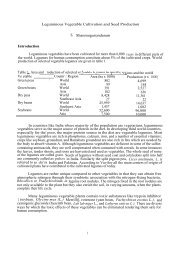Management of the Diamondback Moth and Other Crucifer Insect ...
Management of the Diamondback Moth and Other Crucifer Insect ...
Management of the Diamondback Moth and Other Crucifer Insect ...
You also want an ePaper? Increase the reach of your titles
YUMPU automatically turns print PDFs into web optimized ePapers that Google loves.
Studies on <strong>the</strong> biology <strong>and</strong>toxicity <strong>of</strong> newerinsecticide molecules oncabbagehead caterpillar,Crocidolomia binotalis(Zeller) (Lepidoptera:Pyralidae) in IndiaKannan, M.ASSISTANT PROFESSOR, DEPARTMENT OFAGRICULTURAL ENTOMOLOGY, TAMIL NADUAGRICULTURAL UNIVERSITY, COIMBATORE 641 003, INDIAentokan@yahoo.co.inVijayaraghavan, C.ASSISTANT PROFESSOR, DEPARTMENT OFAGRICULTURAL ENTOMOLOGY, TAMIL NADUAGRICULTURAL UNIVERSITY, COIMBATORE 641 003, INDIAvijayaraghavanento@yahoo.co.inJayaprakash, S.A.Ph.D SCHOLAR, DEPARTMENT OF AGRICULTURALENTOMOLOGY, TAMIL NADU AGRICULTURAL UNIVERSITY,COIMBATORE 641 003, INDIAentojp@gmail.comUthamsamy, S.FORMER PROFESSOR, DEPARTMENT OF AGRICULTURALENTOMOLOGY, TAMIL NADU AGRICULTURAL UNIVERSITY,COIMBATORE 641 003, INDIAuthamasamy@yahoo.comABSTRACTThe biology, morphometrics, growth <strong>and</strong> development<strong>and</strong> susceptibility <strong>of</strong> cabbagehead caterpillar,Crocidolomia binotalis (Zeller) to new moleculeinsecticides were studied in laboratory conditions oncauliflower. The female moths laid <strong>the</strong>ir eggs in 7-12masses <strong>of</strong> 15-80 eggs/mass on <strong>the</strong> abaxial surface <strong>of</strong> <strong>the</strong>leaves with incubation period <strong>of</strong> 3 days. The first,second, third, fourth <strong>and</strong> fifth instars <strong>of</strong> larvae lasted for2.50, 2.50, 2.00, 2.00 <strong>and</strong> 2.00 days respectively. Theprepupal <strong>and</strong> pupal periods lasted for 1.00 to 2.00 <strong>and</strong>6.00 to 8.00 days, respectively. The longevity <strong>of</strong> male<strong>and</strong> female moths after oviposition was 2.50 <strong>and</strong> 1.50days respectively. The total life cycle <strong>of</strong> male <strong>and</strong> femaleon cauliflower lasted for 32.50 <strong>and</strong> 31.50 days,respectively. The larva consumed on average 3181.21 mgcauliflower leaves during its growth period, <strong>of</strong> which85.8 per cent was consumed during <strong>the</strong> last instar.Approximate digestibility (AD) <strong>and</strong> efficiency <strong>of</strong>conversion <strong>of</strong> ingested food (ECI) declined progressivelyto <strong>the</strong> lowest (14.60 <strong>and</strong> 9.16%) in <strong>the</strong> fifth instar,whereas efficiency <strong>of</strong> conversion <strong>of</strong> digested food (ECD)increased to <strong>the</strong> highest level (62.70%) in <strong>the</strong> last instar.On <strong>the</strong> basis <strong>of</strong> LC50 values, <strong>the</strong> order <strong>of</strong> toxicity wasemamectin benzoate > spinosad > indoxacarb >azadirachtin > quinalphos with <strong>the</strong>ir corresponding LC50values being 0.0221, 0.0323, 0.0763, 0.1791 <strong>and</strong> 1.6955ppm, respectively.INTRODUCTIONThe importance <strong>of</strong> vegetables as protective foods <strong>and</strong> assuppliers <strong>of</strong> adequate quantities <strong>of</strong> vitamins, proteins,carbohydrates <strong>and</strong> minerals is well known. The per capitaconsumption <strong>of</strong> vegetables in India is only 135 g,although dieticians recommend 285 g for an adult perday for maintenance <strong>of</strong> health. The existing area undervegetable cultivation in India is around 6.7 millionhectares with production <strong>of</strong> about 101.44 million tonnes.Cauliflower, Brassica oleracea var. botrytis, is <strong>the</strong> mostimportant cole vegetable crop grown in tropical <strong>and</strong>subtropical regions <strong>of</strong> India with an area <strong>of</strong> 2.79 lakhhectares <strong>and</strong> 44.44 lakh tonnes <strong>of</strong> production(Weinberger <strong>and</strong> Srinivasan 2009). Cauliflower remainsa very important crop for smallholder farmers, providingincome <strong>and</strong> nutrition <strong>and</strong> enabling small farms to remainfinancially viable, especially in <strong>the</strong> rapidly growing periurbanfarming sector. Cultivation <strong>of</strong> cauliflower is alsoassociated with some insect pests. Among <strong>the</strong> variousinsect pests, <strong>the</strong> diamond back moth, Plutella xylostella(L.) is <strong>the</strong> most harmful <strong>and</strong> economically important pest<strong>of</strong> cauliflower in India. However, <strong>the</strong> cabbage headcaterpillar, Crocidolomia binotalis (Zeller) (Lepidoptera:Pyralidae) which is <strong>the</strong> secondary pest <strong>of</strong> cauliflower,may become serious during <strong>the</strong> dry season. It also causesconsiderable yield loss to cruciferous crops likecauliflower, cabbage, radish <strong>and</strong> mustard.The cauliflower leaves are skeletonised by <strong>the</strong> larvae <strong>of</strong>C. binotalis <strong>and</strong> <strong>the</strong>y remain on <strong>the</strong> under surface <strong>of</strong>leaves in webs. The developed larvae feed on <strong>the</strong>mvoraciously <strong>and</strong> severe infestation results in entiredefoliation <strong>of</strong> <strong>the</strong> plant. The quantitative consumption <strong>of</strong>food by an insect is <strong>the</strong> total response to feed as a wholewith its nutrients, water contents <strong>and</strong> o<strong>the</strong>r physical aswell as chemical components. <strong>Insect</strong> nutritional studiesprovide valuable information on <strong>the</strong> energy metabolism<strong>of</strong> biochemical components in insect body, <strong>and</strong> also cancontribute key points to develop new managementstrategies. A larval density <strong>of</strong> 2-3 per plant could destroy<strong>the</strong> primordial tissues in cauliflower <strong>and</strong> prevent <strong>the</strong>establishment <strong>of</strong> young plants (Nagarkatti <strong>and</strong> Jayanth1982). Information on <strong>the</strong> biology, morphometrics,susceptibility to new group <strong>of</strong> insecticides <strong>and</strong> quantity<strong>of</strong> food eaten by C. binotalis on cauliflower in India willbe useful to develop effective pest management strategiesin <strong>the</strong> future.MATERIALS AND METHODSBiology <strong>and</strong> morphometrics <strong>of</strong> C.binotalisThe biology <strong>and</strong> morphometrics <strong>of</strong> leaf webber, C.binotalis (Zeller) on cauliflower was studied duringJanuary to March, 2008 in <strong>the</strong> Department <strong>of</strong>Agricultural Entomology, Tamil Nadu AgriculturalUniversity, Coimbatore, Tamil Nadu, India. Late instarlarvae <strong>of</strong> C. binotalis were collected from cauliflowerThe 6th International Workshop on <strong>Management</strong> <strong>of</strong> <strong>the</strong> <strong>Diamondback</strong> <strong>Moth</strong> <strong>and</strong> O<strong>the</strong>r <strong>Crucifer</strong> <strong>Insect</strong> Pests 31
















